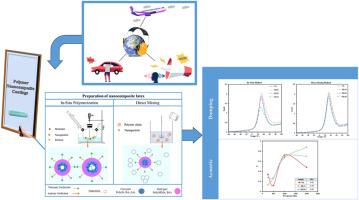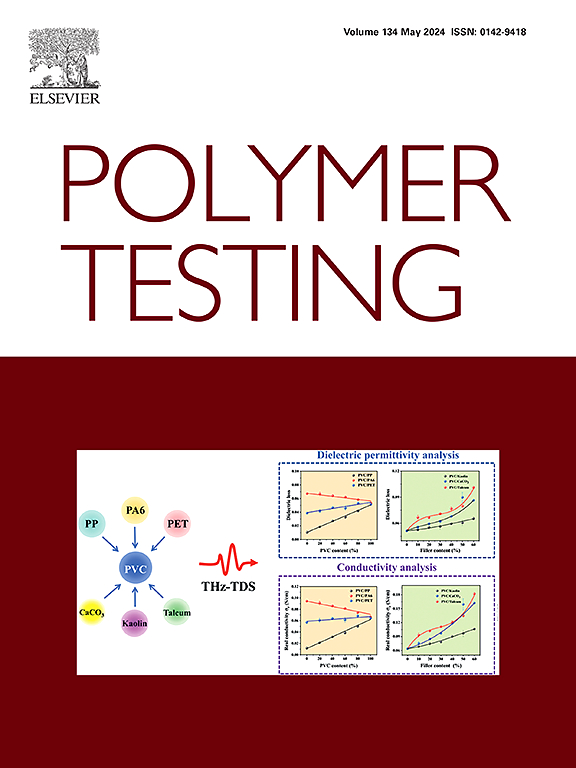纳米二氧化硅填充聚(苯乙烯-丙烯酸酯)互穿聚合物网络(IPNs)的阻尼和声学特性:纳米复合材料制备方法的影响
IF 5
2区 材料科学
Q1 MATERIALS SCIENCE, CHARACTERIZATION & TESTING
引用次数: 0
摘要
减少噪音污染的研究主要集中在利用阻尼涂层和聚合物纳米复合材料来增强吸音效果。通过原位乳液聚合和直接混合的方法制备了纳米二氧化硅/聚(苯乙烯-丙烯酸酯)纳米复合材料,纳米二氧化硅的浓度分别为 1、2 和 3 wt%。傅立叶变换红外光谱(FTIR)显示,在原位合成技术中加入含表面活性剂的胶束和延长合成时间增强了纳米二氧化硅与聚合物链之间的相互作用。动态光散射(DLS)分析表明,纯胶乳和纳米复合胶乳的多分散指数(PDI)呈单峰分布,且范围在可接受的范围内。纳米二氧化硅的加入增强了胶乳颗粒的稳定性,这在直接混合法中尤为明显。场发射扫描电子显微镜(FESEM)和透射电子显微镜(TEM)图像证实,在原位法中,纳米颗粒在聚合物基质中的分散性更好。在原位合成法中,纳米二氧化硅的加入显著增加了假塑性和粘度。在原位合成和直接混合技术中,添加 1 wt% 的纳米二氧化硅可将纳米复合薄膜的阻尼系数提高到约 2,但当纳米二氧化硅含量进一步提高到 3 wt% 时,阻尼系数有所下降。声学测试表明,纳米二氧化硅的吸音效果有所改善,原位合成和直接混合的降噪系数(NRC)值分别为 0.49 和 0.46。在所有纳米粒子含量水平上,直接混合法都显著提高了拉伸性能。与纯聚合物薄膜相比,干燥的纳米复合薄膜具有更强的紫外线阻隔能力。本文章由计算机程序翻译,如有差异,请以英文原文为准。

Damping and acoustic properties of nanosilica filled poly(styrene-acrylate) interpenetrating polymer networks (IPNs): Effect of nanocomposite preparation method
Research on noise pollution reduction has focused on utilizing damping coatings and polymer nanocomposites to enhance sound absorption. Nanosilica/poly(styrene-acrylate) nanocomposites as a water-based coating were prepared through in-situ emulsion polymerization and direct mixing methods at varying concentrations of 1, 2, and 3 wt% of nanosilica. Fourier transform infrared (FTIR) spectroscopy revealed that the inclusion of surfactant-containing micelles and a more extended synthesis period in the in-situ synthesis technique enhanced the interaction between silica nanoparticles and polymer chains. Dynamic light scattering (DLS) analysis showed a unimodal distribution and an acceptable range of polydispersity index (PDI) for neat and nanocomposite latexes. The addition of silica nanoparticles enhanced the stability of latex particles, especially evident in the direct mixing method. The field emission scanning electron microscopy (FESEM) and transmission electron microscopy (TEM) images confirmed the better dispersion of nanoparticles within the polymer matrix in the in-situ method. The addition of nanosilica resulted in a significant increase in pseudoplastic behavior and viscosity, notably in the in-situ synthesis. In both the in-situ synthesis and direct mixing techniques, the addition of 1 wt% of nanosilica resulted in an increase in the damping factor of nanocomposite films to about 2. However, when the nanosilica content was further increased to 3 wt%, the damping factor decreased. Acoustic tests demonstrated improved sound absorption with silica nanoparticles, yielding noise reduction coefficient (NRC) values of 0.49 and 0.46 for in-situ synthesis and direct mixing. The direct mixing method notably enhanced tensile properties at all nanoparticle content levels. Dried nanocomposite films exhibited superior UV-blocking capabilities compared to neat polymer films.
求助全文
通过发布文献求助,成功后即可免费获取论文全文。
去求助
来源期刊

Polymer Testing
工程技术-材料科学:表征与测试
CiteScore
10.70
自引率
5.90%
发文量
328
审稿时长
44 days
期刊介绍:
Polymer Testing focuses on the testing, analysis and characterization of polymer materials, including both synthetic and natural or biobased polymers. Novel testing methods and the testing of novel polymeric materials in bulk, solution and dispersion is covered. In addition, we welcome the submission of the testing of polymeric materials for a wide range of applications and industrial products as well as nanoscale characterization.
The scope includes but is not limited to the following main topics:
Novel testing methods and Chemical analysis
• mechanical, thermal, electrical, chemical, imaging, spectroscopy, scattering and rheology
Physical properties and behaviour of novel polymer systems
• nanoscale properties, morphology, transport properties
Degradation and recycling of polymeric materials when combined with novel testing or characterization methods
• degradation, biodegradation, ageing and fire retardancy
Modelling and Simulation work will be only considered when it is linked to new or previously published experimental results.
 求助内容:
求助内容: 应助结果提醒方式:
应助结果提醒方式:


